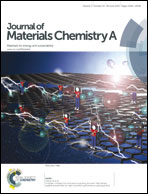The migration mechanism of transition metal ions in LiNi0.5Mn1.5O4†
Abstract
The migration of transition metal ions in the oxygen framework was recently proposed to be responsible for the continuous loss of average working potential of high energy density layered–layered composite cathodes for lithium-ion batteries. The potential migration pathway in a model material, LiNi0.5Mn1.5O4 spinel, was investigated using in situ high-energy X-ray diffraction and in situ neutron diffraction during the solid state synthesis process. It was found that the migration of transition metal ions among octahedral sites is possible by using tetrahedral vacancies as intermediate sites. It was also suggested that the number of electrons in 3d orbitals has a significant impact on their mobility in the hosting oxygen framework.


 Please wait while we load your content...
Please wait while we load your content...